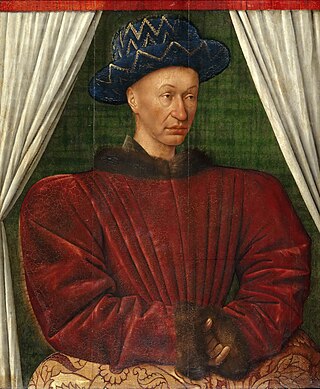| |||||
| Decades: | |||||
|---|---|---|---|---|---|
| See also: | Other events of 1461 History of France • Timeline • Years | ||||
Events from the year 1461 in France
| |||||
| Decades: | |||||
|---|---|---|---|---|---|
| See also: | Other events of 1461 History of France • Timeline • Years | ||||
Events from the year 1461 in France
| | This section needs expansion. You can help by adding to it. (October 2015) |
| | This section needs expansion. You can help by adding to it. (October 2015) |


Charles VII, called the Victorious or the Well-Served, was King of France from 1422 to his death in 1461. His reign saw the end of the Hundred Years' War and a de facto end of the English claims to the French throne.

Charles VI, nicknamed the Beloved and later the Mad, was King of France from 1380 until his death in 1422. He is known for his mental illness and psychotic episodes that plagued him throughout his life.

Maria Christina of the Two Sicilies was Queen of Spain from 1829 to 1833 and queen regent of the kingdom from 1833, when her daughter became queen at age two, to 1840. By virtue of her short marriage to King Ferdinand VII of Spain, she became a central character in Spanish history for nearly 50 years, thanks to introducing a bicameral model of government based on the Bourbon Restoration in France: the Spanish Royal Statute of 1834.

Louis II was Duke of Anjou and Count of Provence from 1384 to 1417; he claimed the Kingdom of Naples, but only ruled parts of the kingdom from 1390 to 1399. His father, Louis I of Anjou—the founder of the House of Valois-Anjou—was a younger son of King John II of France and the adopted son of Queen Joanna I of Naples. When his father died during a military campaign in Naples in 1384, Louis II was still a child. He inherited Anjou from his father, but his mother, Marie of Blois, could not convince his uncles, John, Duke of Berry and Philip II, Duke of Burgundy, to continue her husband's war for Naples. The Provençal nobles and towns refused to acknowledge Louis II as their lawful ruler, but Marie of Blois persuaded them one after another to swear fealty to him between 1385 and 1387.

The Archdiocese of Reims is a Latin Church ecclesiastic territory or archdiocese of the Catholic Church in France. Erected as a diocese around 250 by St. Sixtus of Reims, the diocese was elevated to an archdiocese around 750. The archbishop received the title "primate of Gallia Belgica" in 1089.

Montargis is a commune in the Loiret department, Centre-Val de Loire, France.

The Diocese of Nancy and Toul is a Latin Church ecclesiastical territory or diocese of the Catholic Church in France. After a considerable political struggle between Louis XV, Louis XVI, and the Dukes of Lorraine, the diocese was erected by Pope Pius VI on 17 December 1777. The Diocese of Nancy is a suffragan diocese in the ecclesiastical province of the metropolitan Archdiocese of Besançon.
Events from the year 1910 in the United Kingdom. This year sees a change of monarch.
Events from the year 1685 in England. This year sees a change of monarch.

The Diocese of Laval is a Latin Church ecclesiastical territory or diocese of the Catholic Church in France. The episcopal see is Laval Cathedral in the city of Laval. Created in June 1855, the diocese was originally erected from the Diocese of Le Mans, and corresponds to the department of Mayenne. Under the Ancien Régime the diocese of Mans had an Archdeacon of Laval, whose responsibilities extended over the deaneries of Ernée, Évrun, Laval and Mayenne. The diocese is a suffragan in the ecclesiastical province of the metropolitan Archdiocese of Rennes. The current bishop is Thierry Scherrer, appointed in 2008.

The Diocese of Blois is a Latin Church diocese of the Catholic Church in France. The diocese lies in western France, and encompasses the department of Loir-et-Cher. Since 2002 it has been a suffragan of the Archdiocese of Tours.
Events from the year 1775 in France.
Events from the year 1823 in France.
Events from the year 1801 in France.
Events from the year 1783 in France
Events from the year 1423 in France
Events from the year 1403 in France
Events from the year 1422 in France
Events from the year 1418 in France.
Events from the year 1492 in France